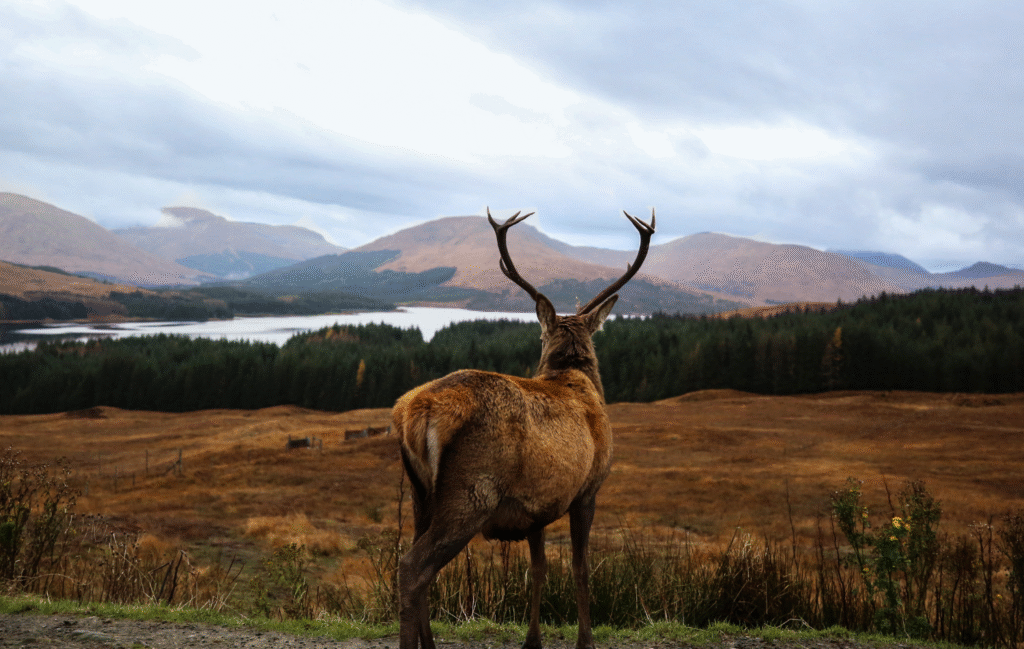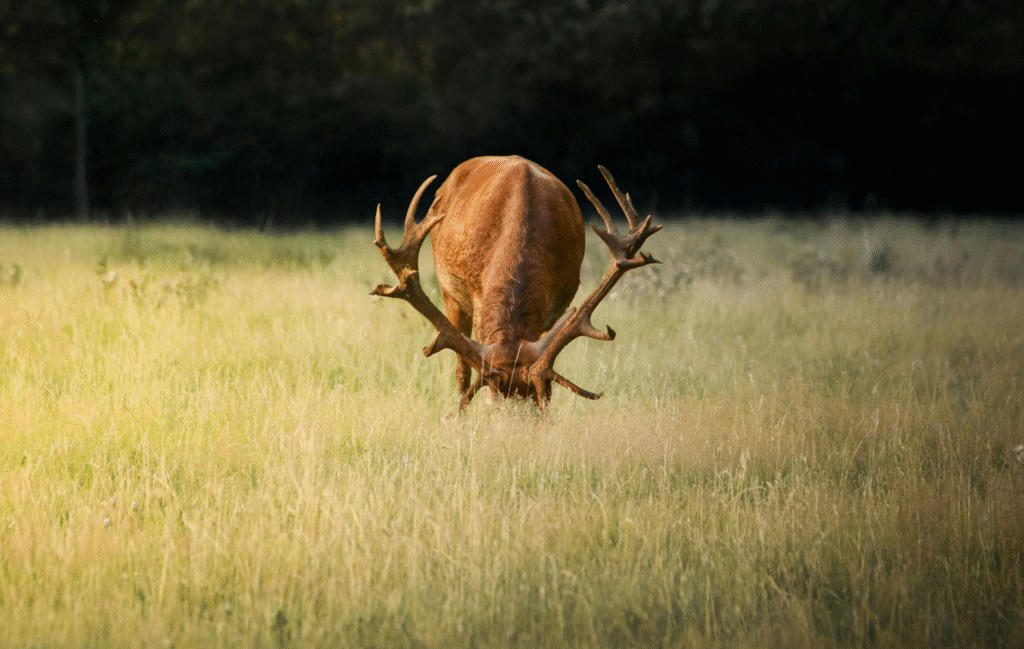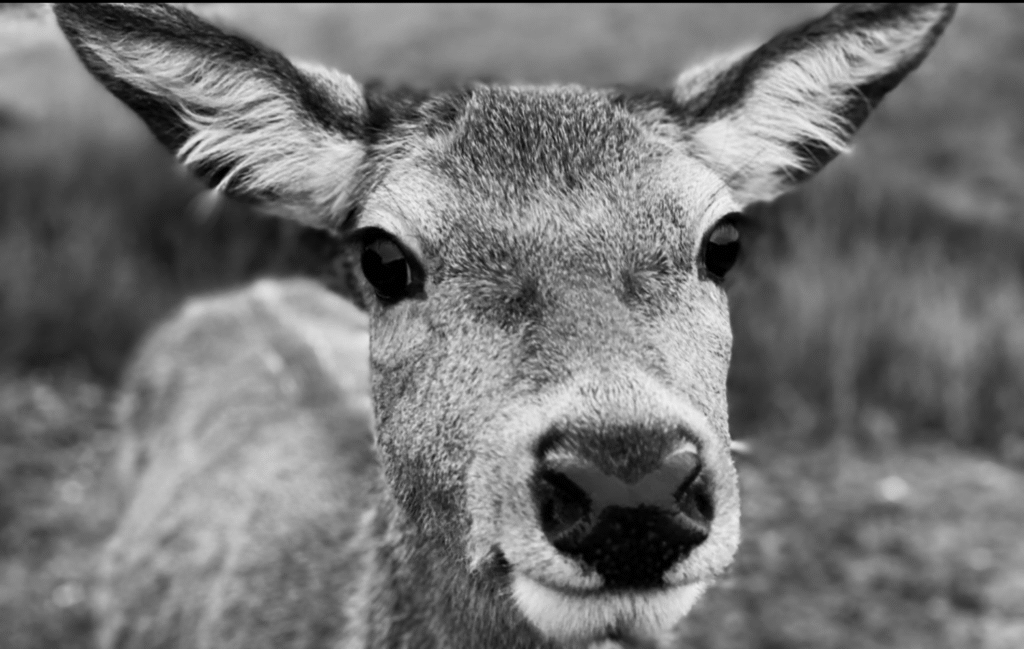Where to See Red Deer in Scotland: A Guide for Wildlife Lovers and Photographers

Scotland’s landscapes are as wild as they are breathtaking . The rugged mountains, sweeping glens, and shimmering lochs that feel like they belong in a fantasy film set, are the perfect backdrop for photography enthusiasts. But beyond the scenery, Scotland is also home to an iconic resident, the red deer. These majestic creatures, with their powerful antlers and elegant stride, are a symbol of the Highlands and one of the most unforgettable sights you can witness in the wild.
And if, like me, you’re an enthusiastic (though very much novice!) amateur photographer, catching a red deer in the right light feels like capturing a piece of pure Scottish magic.
So, grab your walking boots, pack your camera, and let’s take a journey through the best places in Scotland to see and snap red deer.
Why Red Deer Are So Special in Scotland
Red deer are the largest land mammal in the UK, and Scotland is their stronghold. As home to over 350,000 of the beasts, you will often spot them roaming free across glens and hillsides, especially in the Highlands. Autumn is rutting season (late September to early November), when the stags clash antlers in dramatic battles for dominance creating a once-in-a-lifetime sight for wildlife lovers.
For photographers, the rut is particularly exciting. The misty mornings, golden light, and roaring stags on the hills make for incredible photo opportunities. Just remember to keep a respectful distance these animals are wild and deserve space.
But there’s more to these magnificent animals than meets the eye. Here are a few fascinating facts to help you appreciate them even more:
- Royal Residents: Red deer are often called the “King of the Glen” and with their stately antlers and proud stance, it’s easy to see why. In Gaelic, they’re known as fiadh ruadh, meaning “the red wild one.”
- Antler Artistry: Only males (stags) grow antlers, which can weigh as much 15kg and are shed and regrown every year. The new antlers can grow by up to 2.5cm per day and are covered in soft “velvet,” rich in blood vessels that help them grow.
- The Roar of the Rut: During autumn’s rutting season (September to November), stags roar to attract hinds (females) and challenge rivals. Their echoing bellows fill the glens, a sound that defines the Highlands in autumn.
- Super Swimmers: Red deer are surprisingly good swimmers. They’ve been known to cross lochs or even swim between islands in the Hebrides!
- Changing Coats: Their coat colour changes with the seasons, reddish-brown in summer and a thicker, greyer coat in winter to help them blend in and stay warm.
- Highland Hercules: A mature stag can weigh up to 190kg and stand over 1.2m at the shoulder. Imagine meeting one of those on a misty morning walk!
Beyond their biology, red deer also have a place in Scottish folklore. Once considered sacred messengers from the spirit world. In Celtic mythology, the stag symbolised the forest’s guardian, leading hunters between the realms of the human and the wild.

Best Time of Year to See Red Deer in Scotland
Red deer can be spotted all year round, but each season offers something unique:
- Autumn (September–November): The rutting season. Stags roar, posture, and battle for dominance in dramatic displays.
- Winter (December–February): Deer often descend from the higher hills to the glens in search of food, making them easier to spot against snow-dusted backdrops. And the winter light can be spectacular for photos.
- Spring (March–May): A calmer time of year, when the herds are more relaxed. Come May, you may spot calves (fawns) appearing, which is a heartwarming sight for nature lovers.
- Summer (June–August): The stags are in “velvet,” with new antlers growing soft and furry. While long daylight hours can make spotting the deer trickier, early morning and evening remain the best times to catch them.
Top Places to See Red Deer in Scotland
Glen Etive, Argyll
If you’ve seen the James Bond film Skyfall, you’ll recognise this dramatic glen instantly. Glen Etive is part of the stunning Glencoe region, with incredible hiking and photography opportunities. For beginner photographers (like me), this is a dream locations and you won’t need a telephoto lens the size of a bazooka to get a decent shot!
Other things to do nearby:
- Drive the stunning road down to Loch Etive for jaw-dropping views.
- Head into nearby Glencoe for some of the best hiking in Scotland.
Isle of Jura
On Jura, there are literally more deer than people! They’re everywhere, from the hills to the shoreline, and the backdrop of the Paps of Jura makes for spectacular photos.
Daylight adventures:
- Catch a boat trip around the island to spot seals and sea eagles.
- Take a whisky tour at Jura Distillery.
The Cairngorms National Park
Head out at dawn or dusk for your best chance of seeing deer silhouetted against the hills of the Cairngorms National Park. If you’re into photography, the soft Highland light here can turn a simple shot into a work of art.
Other highlights in the Cairngorms:
- Ride the Cairngorm Mountain Railway for panoramic views.
- Visit Loch an Eilein, one of the prettiest lochs in Scotland.
Rannoch Moor
Vast, wild, and hauntingly beautiful, Rannoch Moor is where you truly feel the scale of Scotland’s wilderness. Red deer can often be seen grazing or moving across the open landscape, creating those epic, postcard-worthy shots.
Other things to enjoy:
- Take the West Highland Line train across the moor. This is one of the most scenic railway journeys in the world.
- Explore nearby Kinloch Rannoch village for cosy cafés.
Isle of Rum, Inner Hebrides
The Isle of Rum is famous for its red deer research project, one of the longest-running wildlife studies in the world. That means you’ll have plenty of chances to spot deer here, along with incredible views over the Cuillin mountains on Skye.
Daylight activities:
- Explore Kinloch Castle, a quirky relic of Edwardian times.
- Hike the island’s trails for unbeatable views of the Hebrides.
Knoydart Peninsula
Often called Britain’s last true wilderness, Knoydart is remote, rugged, and absolutely teeming with red deer. If you’re after that “wild Scotland” feel, this is the place. With no roads in and only accessible by boat or a long hike it really will feel like you are exploring undiscovered lands.
Other must-dos:
- Take a guided wildlife walk to learn more about Knoydart’s flora and fauna.
- Stop by The Old Forge, Britain’s most remote pub.
Galloway Forest Park
You don’t have to head all the way north to see red deer. Galloway Forest Park in southwest Scotland offers some of the best wildlife watching in the Lowlands. With its mix of woodland, lochs, and open hills, it’s a haven for red deer, roe deer, and even wild goats.
The Red Deer Range near Clatteringshaws Loch has a dedicated viewing area and hides where you can watch these magnificent animals up close. It’s perfect for families, beginners, and photographers looking for clear, safe vantage points.
Photography tip: The forest’s Dark Sky Park status means you can photograph deer by day and star trails by night making for two incredible subjects in one visit!
Other things to do nearby:
- Visit the Scottish Dark Sky Observatory site or join a stargazing session.
- Explore Loch Trool and hike the Bruce’s Stone Trail for history and Highland views.
Tips for Spotting and Photographing Red Deer in Scotland
Even if your photos don’t turn out as National Geographic-worthy as you’d hoped, check out our beginner’s guide to wildlife photography in Scotland for extra tips.
- Respect their space: Always observe from a safe distance, especially during the rut when stags can be aggressive.
- Time it right: Dawn and dusk are prime times for deer activity and the light is perfect for photos.
- Bring the right lens (if you can): A telephoto lens (200mm or more) will help you capture deer without disturbing them.
- Stay downwind and quiet: Deer have excellent senses, so move slowly and keep noise to a minimum.

FAQ: Red Deer in Scotland
Can you see red deer near Edinburgh or Glasgow?
Yes. While the Highlands are the best place, you don’t need to travel too far. In the Pentland Hills near Edinburgh, red deer are occasionally seen. Near Glasgow, head north towards Loch Lomond and The Trossachs National Park for much better chances.
What time of day is best for spotting red deer?
Dawn and dusk are the golden hours. Deer are more active, and the light is perfect for photos.
Do you need special equipment to photograph red deer?
Not necessarily! Even beginners can get memorable shots, but a zoom lens helps.
Are red deer dangerous?
Generally, red deer are not dangerous. If left undisturbed, they will keep their distance. However, during the rut (autumn), stags can be aggressive. Always watch from afar.
Where is the best place overall to see red deer?
For easy access: Glen Etive. For a truly wild experience: Knoydart or the Isle of Jura.
Final Thoughts
Whether you’re wandering through the misty glens of Glencoe, sailing to a Hebridean isle, or trekking across the Cairngorms, there’s always more Scottish adventures waiting for you. For photographers (even amateur ones like me), it’s an opportunity to chase that perfect shot; a stag standing proud against the Highlands, antlers glowing in the golden light.
So pack your camera, lace up your boots, and set out in search of Scotland’s red deer, because nothing captures the wild spirit of this country quite like them.
